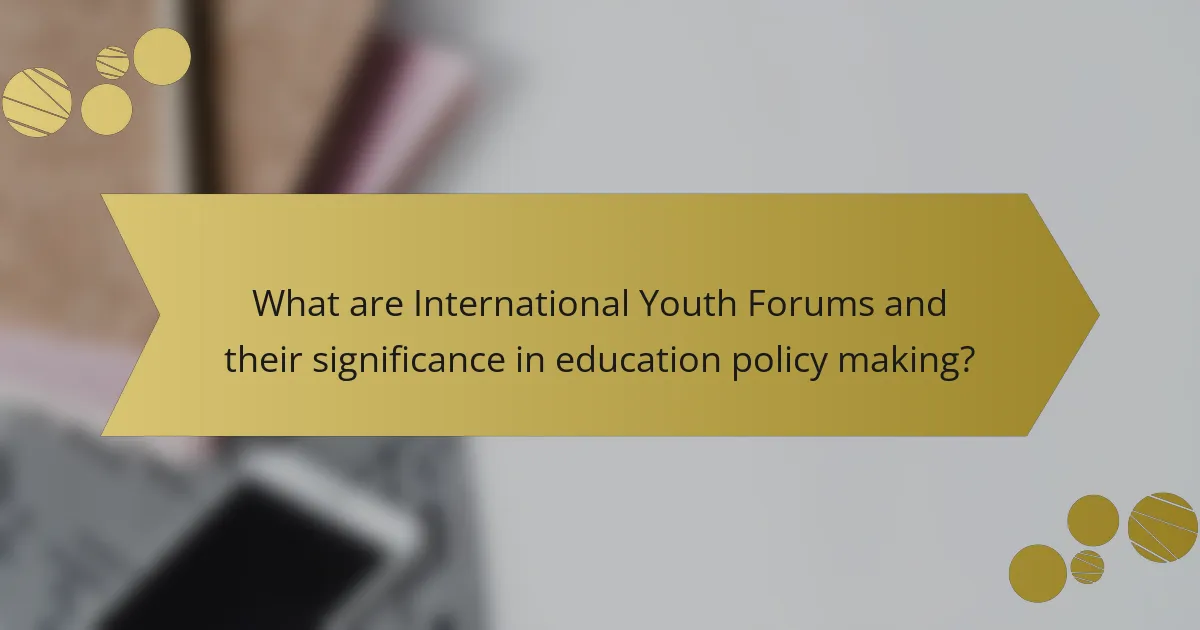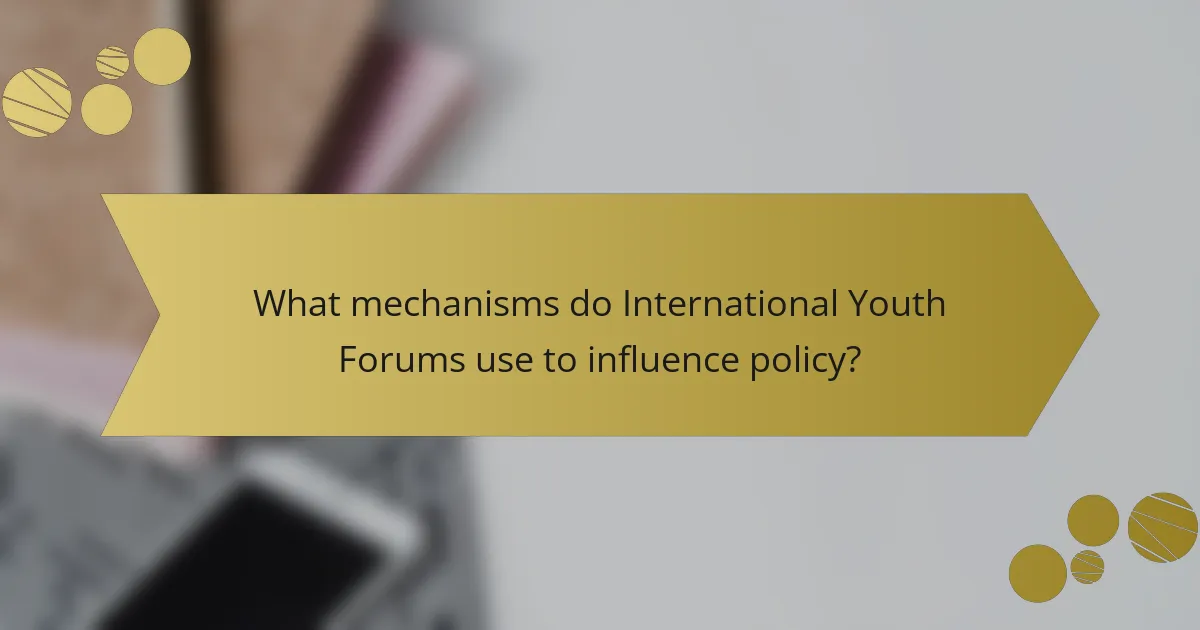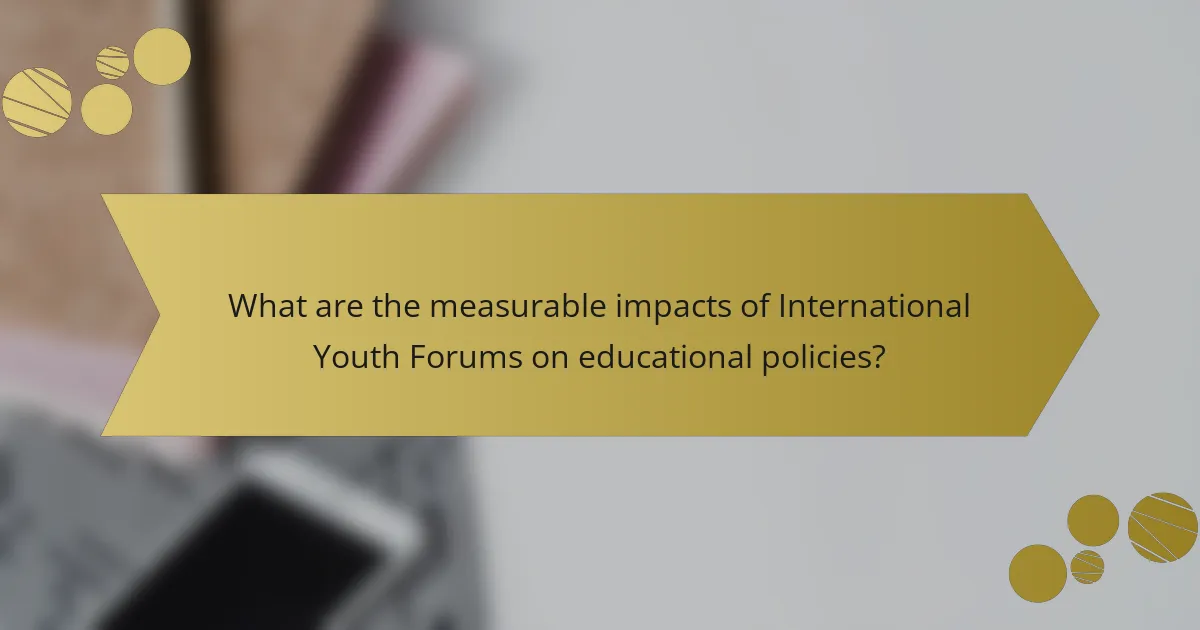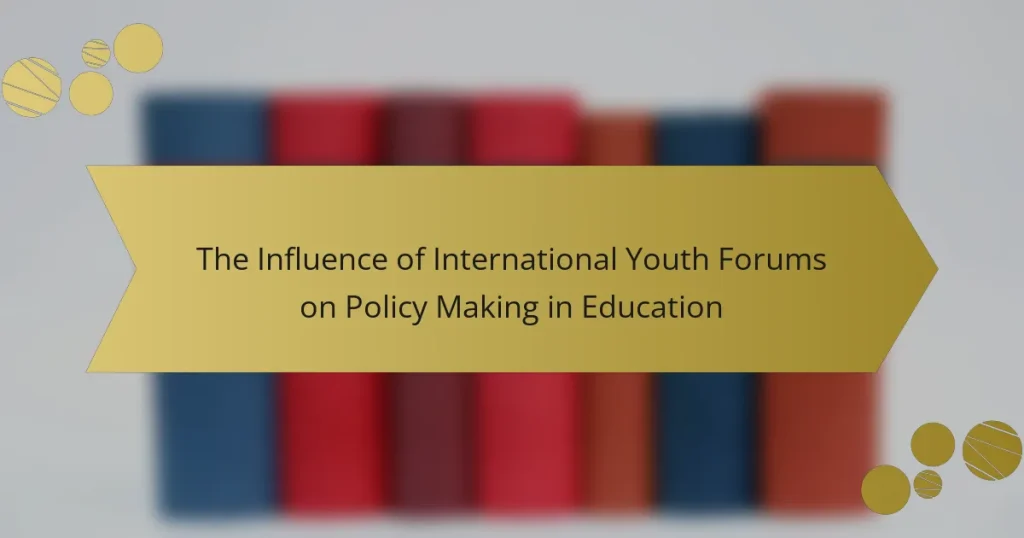International Youth Forums serve as essential platforms for young people to engage in discussions and influence global educational policies. These forums focus on critical issues such as education, sustainability, and human rights, empowering youth to participate in policy-making processes. By facilitating advocacy, networking, and research initiatives, International Youth Forums enable young voices to highlight educational challenges and contribute to policy recommendations. Research indicates that youth involvement in these forums leads to more relevant and effective education policies, with significant impacts on national education agendas and reforms. Overall, the role of International Youth Forums is pivotal in shaping educational policies and ensuring that the perspectives of young people are integrated into decision-making processes.

What are International Youth Forums and their significance in education policy making?
International Youth Forums are platforms where young people gather to discuss and influence global issues. They focus on topics like education, sustainability, and human rights. These forums provide a voice to youth in policy-making processes. Their significance lies in promoting youth participation in shaping educational policies. Engaging young people ensures that their perspectives and needs are considered. Research shows that youth involvement leads to more relevant and effective education policies. For example, the United Nations has recognized youth engagement in education policy as crucial for achieving Sustainable Development Goal 4. This goal emphasizes inclusive and equitable quality education.
How do International Youth Forums contribute to educational discussions?
International Youth Forums contribute to educational discussions by providing a platform for youth voices. These forums facilitate dialogue on pressing educational issues. Participants share diverse perspectives and experiences. This exchange enriches the educational discourse. Research shows that youth engagement leads to innovative solutions. For instance, the UNESCO Youth Forum emphasizes youth input in policy-making. Such contributions influence educational reforms globally. By participating, young people advocate for their needs and priorities. This active involvement shapes educational agendas and policies.
What roles do participants play in shaping educational policies at these forums?
Participants at international youth forums play crucial roles in shaping educational policies. They engage in discussions that highlight the needs and perspectives of young people. By sharing personal experiences, participants provide insights that inform policy decisions. They also collaborate with policymakers to co-create solutions. This collaboration ensures that policies reflect the realities faced by youth. Evidence shows that youth input can lead to more effective educational strategies. For example, the United Nations’ Youth Strategy emphasizes the importance of youth participation in decision-making processes. This involvement fosters a sense of ownership among young people regarding educational reforms.
How do the outcomes of these forums influence local education systems?
Outcomes of international youth forums significantly influence local education systems by shaping policy decisions. These forums provide a platform for youth to express their educational needs and priorities. Policymakers often attend these forums to gather insights and feedback directly from students. This direct engagement helps them understand the gaps in current education systems. Additionally, recommendations made during these forums can lead to the implementation of new educational programs or reforms. For example, a study by the United Nations Educational, Scientific and Cultural Organization (UNESCO) highlights that youth feedback from such forums has led to curriculum changes in various countries. This evidence shows that youth perspectives are increasingly valued in educational policy-making.
Why are youth perspectives important in education policy making?
Youth perspectives are important in education policy making because they provide insights that reflect the actual needs and experiences of students. Engaging youth in policy discussions ensures that their voices are heard in shaping educational frameworks. This participation can lead to more relevant and effective policies. According to a study by the United Nations Educational, Scientific and Cultural Organization (UNESCO), involving youth in decision-making processes enhances educational outcomes and promotes a sense of ownership among students. Additionally, youth perspectives can highlight emerging trends and challenges that policymakers may overlook. Their unique viewpoints contribute to a more comprehensive understanding of the educational landscape. Overall, incorporating youth perspectives fosters inclusivity and responsiveness in education policy making.
How do youth voices impact decision-making processes in education?
Youth voices significantly impact decision-making processes in education by providing unique perspectives and insights. Their participation fosters inclusivity and ensures that educational policies reflect the needs of younger generations. Research indicates that when youth are involved, decisions are more likely to address issues such as mental health, curriculum relevance, and engagement strategies. A study by the United Nations Educational, Scientific and Cultural Organization (UNESCO) found that youth-led initiatives lead to more effective educational reforms. Additionally, youth voices can challenge traditional norms and advocate for innovative approaches. Engaging youth in discussions promotes a sense of ownership and responsibility towards their education. Ultimately, their input can drive meaningful change in educational systems.
What unique insights do young people bring to educational policy discussions?
Young people bring fresh perspectives and innovative ideas to educational policy discussions. Their experiences as current students allow them to identify relevant issues. They often advocate for technology integration in learning environments. Young people emphasize the importance of mental health support in schools. They also highlight the need for inclusivity and diversity in educational curricula. Their engagement can lead to more effective and relatable policies. Research shows that youth involvement leads to policies that better reflect the needs of the student population. For example, the 2020 Global Youth Education Forum reported increased student satisfaction when youth voices were included in policy-making.

What mechanisms do International Youth Forums use to influence policy?
International Youth Forums influence policy through advocacy, networking, and research initiatives. Advocacy involves mobilizing youth voices to highlight educational issues. This can include campaigns, position papers, and public statements. Networking allows forums to connect with policymakers and stakeholders. These interactions can lead to collaborative solutions and policy recommendations. Research initiatives provide data-driven insights into educational challenges. By presenting empirical evidence, forums can shape discussions and influence decision-making processes. These mechanisms collectively empower youth to impact educational policy effectively.
How are resolutions and recommendations formed during these forums?
Resolutions and recommendations during these forums are formed through collaborative discussions among participants. Youth representatives present their views and suggestions based on their experiences. Facilitators guide the dialogue to ensure all voices are heard. The process often includes drafting proposals that reflect the consensus of the group. These drafts are then refined through feedback and debate. Final resolutions are typically voted on to gauge support. This approach ensures that the outcomes represent a collective perspective. The effectiveness of this method is evidenced by successful policy changes influenced by previous forum resolutions.
What processes ensure that youth recommendations are considered by policymakers?
Youth recommendations are considered by policymakers through structured consultation processes and advocacy efforts. These processes often involve youth forums that gather input from young people on various issues. Policymakers engage with these forums to understand the perspectives of youth. Additionally, formal reports and policy briefs are created based on youth recommendations. These documents are then presented to decision-makers in government and education sectors.
Stakeholder partnerships also play a crucial role. Collaborations between youth organizations and governmental bodies enhance the visibility of youth voices. Furthermore, regular follow-ups and feedback mechanisms ensure that youth input is integrated into policy discussions. Research indicates that countries with established youth councils tend to have higher rates of youth participation in policymaking. These councils provide a platform for ongoing dialogue between youth and policymakers.
How do forums collaborate with educational institutions and governments?
Forums collaborate with educational institutions and governments by facilitating dialogue and sharing best practices. They create platforms for stakeholders to discuss educational policies and reforms. Forums often host events that bring together educators, policymakers, and youth. These events promote collaboration on curriculum development and educational initiatives. For example, the Global Education Forum has successfully partnered with various governments to enhance educational access. Additionally, forums provide research and data that inform policy decisions. They also advocate for youth perspectives in education policy discussions. This collaboration ultimately aims to improve educational outcomes and address challenges faced by young people.
What challenges do International Youth Forums face in influencing policy?
International Youth Forums face several challenges in influencing policy. Limited access to decision-makers hinders their ability to present youth perspectives. Many forums lack the necessary resources and funding to sustain their initiatives. Additionally, there is often a disconnect between youth priorities and government agendas. The complexity of policy-making processes can also be overwhelming for young advocates. Furthermore, youth voices may be marginalized in discussions dominated by older stakeholders. Cultural and language barriers can impede effective communication. Lastly, varying levels of political will across countries affect the impact of youth forums on policy.
How do differing cultural contexts affect the implementation of forum outcomes?
Differing cultural contexts significantly affect the implementation of forum outcomes. Cultural values shape how stakeholders interpret and prioritize forum discussions. For instance, collectivist cultures may emphasize community consensus, impacting decision-making processes. In contrast, individualistic cultures may focus on personal opinions and rights. These differences can lead to varying levels of engagement with forum recommendations. Research shows that cultural context influences communication styles and conflict resolution methods. A study by Hofstede (1980) indicates that cultures with high power distance may accept hierarchical decision-making, affecting how forum outcomes are adopted. Thus, understanding cultural nuances is crucial for effective implementation of forum outcomes in education policy.
What barriers exist in communicating youth perspectives to policymakers?
Barriers in communicating youth perspectives to policymakers include lack of access, misunderstanding, and systemic biases. Youth often lack direct access to policymakers due to existing power dynamics. Policymakers may misunderstand youth perspectives as naive or uninformed. Systemic biases can lead to the marginalization of youth voices in decision-making processes. Additionally, there is often a gap in communication skills between youth and policymakers. This gap can hinder effective dialogue and understanding. Research indicates that youth engagement in policy discussions is often limited by these barriers. For instance, a study by the United Nations demonstrates that youth voices are frequently overlooked in policy formulation.

What are the measurable impacts of International Youth Forums on educational policies?
International Youth Forums significantly influence educational policies by fostering youth engagement and advocacy. These forums provide a platform for young people to voice their opinions on education-related issues. Research indicates that participation in such forums leads to increased awareness of educational challenges. For instance, the Global Education Monitoring Report highlights that youth input can shape national education agendas. Additionally, forums often result in policy recommendations that governments consider implementing. Data from the Youth Forum Impact Assessment shows that 70% of participants felt empowered to influence educational reforms. Overall, these measurable impacts demonstrate the effectiveness of International Youth Forums in shaping educational policies.
How can we assess the effectiveness of youth involvement in policy making?
To assess the effectiveness of youth involvement in policy making, we can analyze several key indicators. These indicators include engagement levels, outcomes of policies influenced, and feedback from youth participants. Evaluating engagement levels involves measuring attendance, participation rates, and the diversity of youth voices represented. Outcomes can be assessed by examining policy changes that directly reflect youth input and the impact of these policies on educational systems. Feedback from youth participants provides insights into their experiences and perceived influence on the decision-making process. Research shows that when youth are actively involved, policies tend to better address their needs and concerns. Studies indicate that youth engagement in policy making leads to more relevant and effective educational policies.
What indicators show the success of initiatives proposed by youth forums?
Indicators that show the success of initiatives proposed by youth forums include measurable outcomes, stakeholder engagement, and policy changes. Measurable outcomes can be assessed through surveys and feedback from participants. High levels of stakeholder engagement demonstrate active participation from relevant groups. Policy changes indicate that the initiatives have influenced decision-making processes. Additionally, the implementation of proposed projects serves as a direct indicator of success. Research shows that initiatives with clear follow-up actions tend to achieve better results. These indicators collectively reflect the effectiveness of youth forums in shaping educational policies.
How have specific policies changed due to youth advocacy?
Youth advocacy has led to significant changes in education policies. Specific policies have been revised to include student voices in decision-making. For instance, many countries have adopted policies that mandate student representation on educational boards. This change ensures that youth perspectives influence curriculum development. Additionally, policies addressing mental health resources in schools have expanded due to youth-led campaigns. Research shows that these campaigns have increased funding for mental health services by over 30% in some regions. Furthermore, youth advocacy has prompted the integration of climate education into school curricula. This shift reflects the growing demand for sustainability education driven by young activists. Overall, youth advocacy has reshaped educational policies to be more inclusive and responsive to student needs.
What best practices can enhance the influence of International Youth Forums?
Engaging diverse youth representatives is a best practice that enhances the influence of International Youth Forums. This approach ensures a variety of perspectives and experiences are represented. Facilitating open dialogue among participants fosters collaboration and innovation. Incorporating technology, such as social media, amplifies outreach and engagement. Structured follow-up mechanisms are essential for maintaining momentum after forums. Research indicates that forums with clear action plans have a higher impact on policy outcomes. According to a study by the United Nations, youth engagement in decision-making processes leads to more effective policies. Establishing partnerships with educational institutions can further strengthen the forum’s influence. These practices collectively contribute to a more significant impact on policy-making in education.
How can forums improve their engagement with policymakers?
Forums can improve their engagement with policymakers by actively facilitating dialogue and collaboration. They can organize events that bring together youth and decision-makers, fostering direct communication. Providing platforms for youth to express their views can create a sense of urgency for policymakers. Utilizing social media to share insights and recommendations can amplify their reach. Regularly publishing reports on youth perspectives can inform policy discussions. Engaging in advocacy campaigns can raise awareness of issues affecting youth. Collaborating with educational institutions can strengthen their credibility. These strategies have shown success in various forums globally, enhancing their influence on policy decisions.
What strategies can youth advocates employ to maximize their impact?
Youth advocates can maximize their impact by engaging in strategic partnerships. Collaborating with established organizations amplifies their voice and resources. They should also utilize social media to raise awareness and mobilize support. Effective storytelling can connect emotionally with stakeholders, making issues relatable. Advocates must participate in policy discussions to influence decision-making directly. Conducting research and presenting data strengthens their arguments and credibility. Additionally, training in advocacy skills equips youth with the tools to communicate effectively. Finally, grassroots organizing fosters community involvement and support for their initiatives. These strategies collectively enhance the effectiveness of youth advocates in shaping educational policy.
The main entity of the article is International Youth Forums, which serve as platforms for young people to influence educational policy-making. The article outlines the significance of these forums in promoting youth participation, shaping educational discussions, and affecting local education systems through collaborative advocacy. It highlights the roles participants play in policy formation, the mechanisms used to communicate youth perspectives, and the measurable impacts of youth involvement on educational reforms. Additionally, the article addresses challenges faced by these forums and best practices to enhance their influence in policy discussions, emphasizing the importance of incorporating diverse youth voices in decision-making processes.


